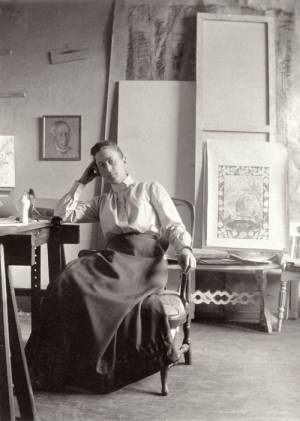Palazzo Strozzi, Florence
27 September 2013 – 19 January 2014
by JULIE BECKERS
“There is no must in art, because art is free.”
Wassily Kandinsky
Elegant yet not for the fainthearted, they include bear-slaying, Siberian shaman rituals and the exploration of “The Other”. I met the curators John E Bowlt, Nicoletta Misler and Evgenija Petrova in the charming Café Giacosa and had a strong espresso before bravely entering their show.
The beautifully illustrated and scholarly written catalogue tackles the ambitious soul of the display. The exhibition aims to show how the development of Russian art in the years 1890 to 1930 was forged through the extension of inner and outer borders. Well-known artists such as Wassily Kandinsky and Kazimir Malevich were joined by some “new faces” and went in search of novel sources of artistic inspiration. Of the many elements that stimulated these artists, the most pertinent were neolithic stone figures, Siberian shaman rituals, Chinese prints, Japanese engravings, theosophical doctrine and Indian philosophy: in short, an exploration of the exotic, the unknown and “The Other”.1
These influences were found within the folk and ritualistic history of Russia itself – the taiga, desert and steppe regions – and, further east, Siberia, China, Tibet, Japan and India. These geographical delineations demonstrate a second aim of Russian Avant-Garde: Siberia and the East; a literal step towards the east and a deliberate move away from the west and the assumption that the Russian avant garde is solely an extension of Paris and Milan.
The exhibition consists of 11 densely populated sections. There is, in other words, a lot to take in. Many of the artefacts on display, some acquired during the 18th and 19th centuries by great Russian explorers, such as the future Tsar Nicolas II, are seen here for the first time outside Russian territory. The rather imposing statue of a Kamennaia baba (stone maiden), a stone guardian of the sort that used to be dotted over the landscape of Imperial Russia, opens the exhibition. This type of image is found throughout the exhibition, placed usually in the middle on lightly coloured pedestals, while the paintings are placed against a white background. This is a deliberate aesthetic decision.
Ethnographical items and specimens of oriental art are displayed more spontaneously, mimicking the curiosity shop where avant-garde artists may have seen these objects. In the first section of the exhibition, the visitor immediately encounters three of the most important paintings, Natal’ia Goncharova’s Emptiness (1913-1914), Kandinsky’s Black Spot (1912) and Malevich’s Black Circle (1915). This first section is strong and convincing; keen observers will immediately notice the stellar works produced by the leading Russian avant-gardists and will be introduced to their “new creative impulses”, influenced by the stone maiden and other significant themes in this section including shamanism and a yearning for the exotic illustrated by works such as the Wolves by Night (1912) by Aleksei Stepanov and Léon Bakst’s Siamese Sacred Dance (1901).
This attraction to the east is further explored in the next sections. Il’ia Mashkov’s Portrait of a Lady in an Armchair (1913) is a good illustration of this fascination with oriental art. Although the Lady may remind the viewer of a Matisse, the lively imagery and vivid colouring of the background were inspired by a Persian Kalamkar (textile). Here, too, are two of Russian artist Alexandre Benois’ drawings from 1914 illustrating the designs of Chinese-style costumes he created for Stravinsky’s opera Le Rossignol (1914).2
Konstantin Korovin’s Caravan of Samoeds (1898), which the artist was commissioned to paint as part of a number of panels for national and international expositions, again gives the viewer a glimpse of the artist’s creative process influenced by the geographical boundaries, Siberia, and rituals of his own varied people. Malevich also explores this notion with his Head (1928-29) inspired by the ritual masks produced by the Koryak people of far east Russia, to enhance successful hunting seasons. In fact, the final sections of the exhibition embrace the highly spiritual ethnographic sculptures produced by these northern souls.3
I was told the exhibition opens and closes with an eclipse, from Malevich to Aleksandr Borisov. Yes, an eclipse as a moment of awareness, a change. But rather than casting a momentary shadow, this display signifies a true eye-opener. Yes, at times there was perhaps a lack of innovation in the show’s design – the controversial and strikingly complex nature of the avant-garde artists could have been better illustrated. Perhaps I missed a bit of controversy. But these small gripes aside, this excellent exhibition is beautifully set within the sturdy walls of a much-loved Florentine Palazzo and shakes us up a bit. It pushes the viewer beyond the, at times, still ignorant western point of view, allowing the visitor to see Russia for what it is – a country filled with a rich culture, folklore and political history that stretches continents and that unquestionably sways as far east as west.
References
1. JE Bowlt, N Misler and E Petrova (eds). The Russian Avant-garde: Siberia and the East (Milan: Skira°, p19; Also used: Press Release.
 With Great Force, Swiftly and Surely
With Great Force, Swiftly and Surely